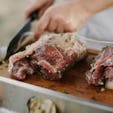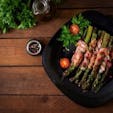“Eat what a caveman would eat.” That’s the premise of The Paleo Diet and the many other Stone Age-themed nutrition approaches out there that all seek to make healthy eating simple. Nevertheless, dieters seem more confused than ever.
Just what exactly did cavemen eat? Will following their example make us healthier, or has humankind evolved to enjoy a wider menu of foods? And would depriving ourselves of them hold back our health and performance? Scroll through our report for the real deal on “going Paleo.”
What Is The Caveman Diet?
Caveman-style eating rose to popularity with the emergence of the best-selling 2001 book The Paleo Diet, by nutrition researcher Loren Cordain, Ph.D (although, to be fair, the idea had circulated even decades earlier). Cordain’s theory is that the genes of modern humans are highly similar to those of people living in the Paleolithic Era (2.5 million to approximately 11,000 years ago)—the period when men began hunting with tools and, yes, often sought shelter in caves. Therefore, by eating the foods that Paleolithic folk ate, we could avoid the health problems associated with a modern diet, including diabetes, obesity, and inflammation.
Caveman Diet Food List
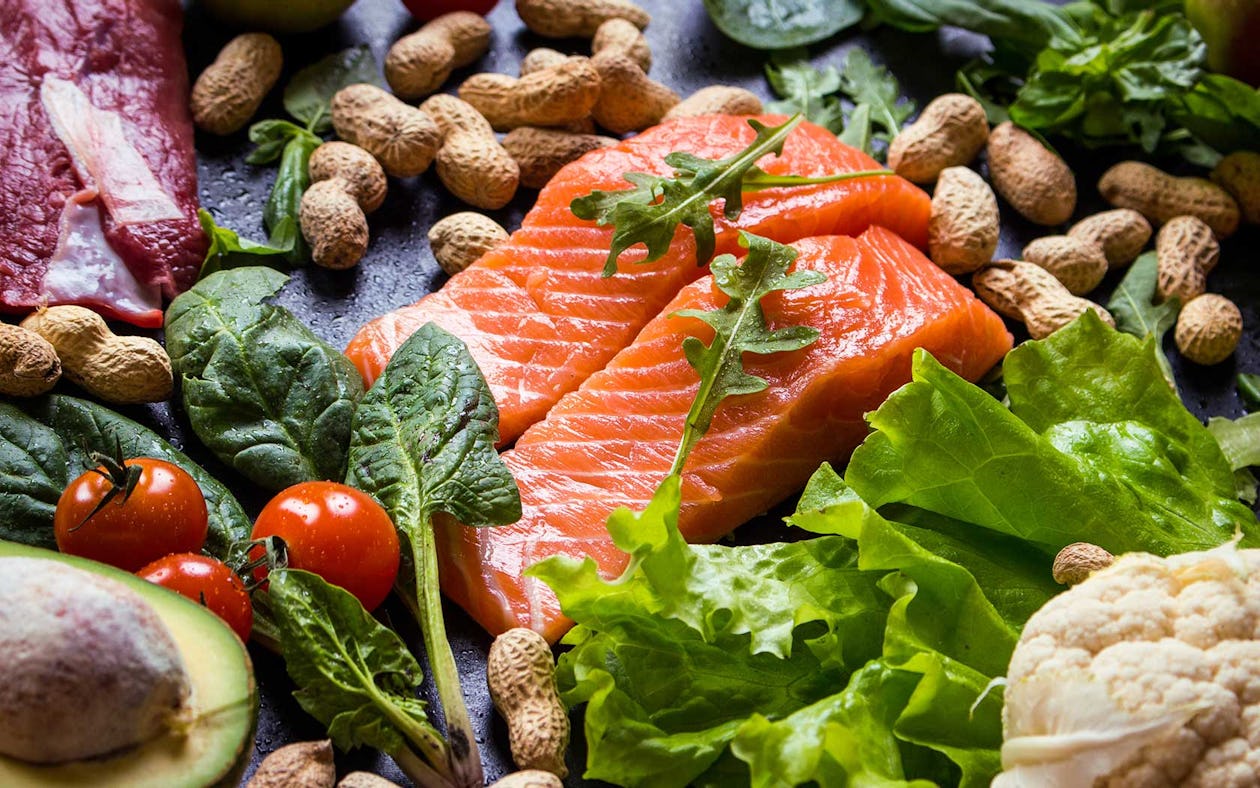 The original Paleo Diet emphasized whole foods that only a hunter-gatherer from Paleo times would have had access to—meats, fish, eggs, vegetables, fruits, roots and tubers, nuts, seeds, and unprocessed oils and fat sources.
The original Paleo Diet emphasized whole foods that only a hunter-gatherer from Paleo times would have had access to—meats, fish, eggs, vegetables, fruits, roots and tubers, nuts, seeds, and unprocessed oils and fat sources.
Some of these include¦
Meats*: chicken, turkey, beef, lamb, pork
Fish and other seafood: tuna, salmon, haddock, mackerel, shrimp, crab, clams, mussels
Vegetables: broccoli, cauliflower, spinach, kale, collard greens, peppers, onions
Fruits: berries, apples, bananas, oranges, pears, pineapple, watermelon, avocados, tomatoes
Roots and tubers: carrots, parsnips, beets, sweet potatoes
Nuts: almonds, walnuts, sunflower seeds, pumpkin seeds
Oils and fats: olive oil, coconut oil, avocado oil, lard, tallow
*Meats should be pasture-raised so they’re as close to what was available to cavemen as possible. All foods should be organic whenever possible as well.
Seasonings made from herbs and spices are also permitted. These include: turmeric, rosemary, paprika, dill, etc.
Foods that are NOT allowed are those that became available with the invention of farming, such as cereal grains, legumes, and dairy. Potatoes, refined sugar/sweets, processed foods, refined vegetable oils, alcohol and salt are also rejected.
The naughty list includes:
Cereal grains: wheat, spelt, barley, oats
Legumes: beans, peanuts
Dairy: milk, cream, cheese, butter, yogurt
Processed foods: soda, pasta, bread, baked goods, chips, crackers
Alcohol and coffee are also NOT allowed.
Take note of the foods that are red-flagged and the reasons why (apart from their having not been available to cavemen).
Why No Grains?
According to Paleo pundits, grains raise blood sugar levels too high, causing the body’s insulin levels to follow suit. That leads to easier fat storage and, long-term, an increased risk of diabetes. They also contain gluten, which as many as 18 million Americans may have some degree of intolerance to, as well as “anti-nutrients”—natural compounds in grains that may harm the gut and prevent the absorption of vitamins and minerals. Despite the nutrients grains can offer, caveman dieters argue that these substances within them negate those benefits entirely.
Why No Legumes?
These are banned for many of the same reasons that grains are, and Loren Cordain has even gone as far as to call them “toxic.” The Paleo crowd also points out that, like grains, they don’t provide as potent and digestible a source of vitamins and minerals as fruits and vegetables do, and their protein is less bioavailable than that found in animal foods.
Why No Dairy?
The potential for allergy and intolerance that results in bloating, cramping, and poor digestion make dairy a no-no to most modern-day cavemen (but not all, as we’ll discuss below). In addition, die-hard Paleo devotees cite research linking dairy to insulin resistance, heart disease, and even acne. Also, the prevalence of potentially harmful hormones and antibiotics in most commercially available dairy products due to modern farming practices is decidedly “not Paleo.”
Why No Potatoes?
This one may be the most puzzling, as potatoes are technically a tuber and other tubers—including sweet potatoes—are Paleo-permissible. But, according to Cordain, potatoes should be avoided because of how they boost blood sugar. They also contain anti-nutrients, and unlike their sweet potato cousins, white potatoes technically did not exist in the Paleolithic Era.
Why No Salt?
The claim here is that salt raises acidity in the body, which then forces the body to draw calcium from the bones. Over time, this can result in osteoporosis and other degenerative diseases.
Why No Coffee?
Apart from the fact that it’s made from beans, and beans are on the banned list, Cordain frowns on the caffeine content. He says anyone who wants to get “the most” out of the Paleo Diet should avoid it, but he offers moderate amounts of green tea in its place, which is high in antioxidants and lower in caffeine.
Sample Caveman Meal Plan
 Here’s an example of how you might eat in a day following a typical caveman approach.
Here’s an example of how you might eat in a day following a typical caveman approach.
Breakfast
â 2 free-range eggs scrambled, cooked in unrefined coconut oil with chopped parsley
â ½ avocado
â 1 cup mixed berries
Lunch
â 8 oz baked salmon
â steamed broccoli with lemon juice
â 4 oz sweet potato
Snack
â 4 fresh figs or 1 cup almonds
Dinner
â 8 oz beef liver, sautéed with onions and garlic
â salad with mixed vegetables, dressed with olive oil
Dessert
â 2 cups peach slices
Caveman Diet Recipes
The following recipe ideas can fit with a caveman diet:
1. Almond Flour Pancakes
2. Burrito Bowl
3. Zucchini Noodles with Homemade Bison Marinara
4. Avocado Pudding
5. Cookie Cake
Caveman Diet Modifications
As the Paleo movement has grown, various researchers and nutrition experts have offered their own slant on it, in many cases broadening the list of foods. Paleo followers who have no trouble digesting dairy consider it to be worth including in the diet, and regularly consume milk, butter, and yogurt.
“I think the modern research supports the idea that full-fat dairy can be beneficial when it’s well tolerated by the individual,” says Chris Kresser, L.Ac, expert on functional and integrative medicine and author of the New York Times best seller, Your Personal Paleo Code. “There have been several studies in the past couple decades linking full-fat dairy with lower risk of cardiovascular disease and metabolic diseases like diabetes and obesity. Having said that, about two-thirds of people around the planet aren’t able to digest lactose and a much smaller percentage may not be able to handle the casein [protein] in dairy products. For those people, despite the benefits, dairy may not be a good idea.”
With that said, Kresser recommends choosing organic dairy derived from grass-fed cows whenever possible, to maximize the nutrition and safety.
For the sake of flavor and enjoyment, many otherwise devoted caveman dieters add salt to their food, and (of course) also drink coffee and alcohol. Furthermore, athletes often argue that the lack of both grains and potatoes makes it too difficult to get the carbs they need to perform at their highest level and recover from exercise. While Paleo-inspired dieting isn’t automatically low carb, athletes’ carb needs are higher than the average person’s and often aren’t met with a standard Paleo approach.
“If you’re doing a lot of physical activity, like jiu-jitsu or CrossFit, I like 30–50% of calories to come from sweet potatoes and less common Paleo starches like plantains, yucca, and taro, which can be found in some ethnic markets,” says Kresser. “I differ from many in the Paleo community by saying that white potatoes are fine sources too, and white rice can help round out the carb intake.”
Caveman Diet Benefits
 Since all varieties of Paleo eating emphasize whole foods, it’s an indisputably healthy (if somewhat restrictive) approach to nutrition. There’s virtually no nutrient important to human health that you can get from grains, legumes, and dairy that you can’t obtain by eating from the list of approved foods, and the Paleo Diet has been shown to stabilize blood sugar, balance energy levels, fight inflammation, improve sleep, and have a host of other health benefits.
Since all varieties of Paleo eating emphasize whole foods, it’s an indisputably healthy (if somewhat restrictive) approach to nutrition. There’s virtually no nutrient important to human health that you can get from grains, legumes, and dairy that you can’t obtain by eating from the list of approved foods, and the Paleo Diet has been shown to stabilize blood sugar, balance energy levels, fight inflammation, improve sleep, and have a host of other health benefits.
“It’s great for normalizing weight,” says Kresser. “And it tends to be a spontaneous weight loss, because most people don’t have to count calories on a Paleo diet to do it.” Because the greenlit foods are nutrient-dense and filling, they’ll satisfy you before you can overeat calories. Caveman eaters also report “a reversal of minor and major health conditions,” says Kresser. “Irritable Bowel Syndrome, skin issues, arthritis, and aches and pains seem to magically disappear.”
Benefits For Athletes
At first glance, the magic of the caveman diet may seem to lie in its nutrition-rich whole foods, but Kresser says there’s more to it than just eating healthy. Other diets that focus on whole foods alone may not be capable of the same results. He notes that vegans—people who may consume a wide range of whole plant foods but no animal products—won’t be exposed to the same diversity of nutrients that caveman dieters are. A big reason for this, says Kresser, is the prevalence of organ meats on caveman eating plans. “Organ meats are more nutrient-dense than vegetables.”
Smart Paleo dieters will take full advantage of the meat group on the approved food list, eating “nose to tail.” Consuming beef liver, chicken hearts, and other animal organs provides a density of micronutrients you can’t get as a vegetarian, and may still lack even if you follow a high-protein fitness diet that’s rich in muscle meats.
“Lean muscle meats and eggs are low in glycine and high in methionine, another amino acid that, when eaten in abundance over glycine, may increase the risk of cancer and other late-life illnesses.”
“There’s a lot of discussion about macronutrient ratios in the fitness community,” says Kresser. “How much protein should I eat? How much fat? And that’s important, but so are micronutrients. How much vitamin A and B are you getting—and iron, copper, and zinc? These are also important for body composition and peak performance.” Organ meats have these nutrients in spades, and hunter-gatherer societies through the ages and throughout the world have prioritized them accordingly.
“Then and even now some cultures throw the muscle meats to the dogs and just consume the organs,” says Kresser. “Centuries ago, they knew, even without access to advanced testing, that organ meats top the list in terms of nutrient density. And the same goes for shellfish—oysters and clams in particular. A few servings a week and you can meet your entire week’s need for those nutrients.” Kresser recommends three to six ounces of beef liver per week, or a three-ounce serving of clams, to stock up on the various B vitamins and minerals you wouldn’t get on a diet of chicken breast and broccoli.
Athletes trying to improve their physiques tend to be focused on macros and choose lean muscle meats for fear that extra fat will turn up as fat on their bodies. According to Kresser, you’d be wise to budget organ meats and other fattier cuts into your fat allowance, and he offers an even more compelling reason beyond just better performance: lower risk of cancer.
“Organs, bone broth, and more gelatinous cuts of beef like oxtail, brisket, and beef shank are high in glycine,” says Kresser, an amino acid that helps form collagen in the body. Lean muscle meats and eggs are low in glycine and high in methionine, another amino acid that, when eaten in abundance over glycine, may increase the risk of cancer and other late-life illnesses.
A study in the journal Aging Cell found that mice that were denied methionine in their diets live longer, and a 2011 report in The Federation of American Societies for Experimental Biology concluded that supplementing with glycine had the same life-extending effect in mice as restricting methionine. Kresser says that it’s more than reasonable to expect the same relationship to exist in humans, and to remember that for thousands of years of human evolution, people ate animals in their entirety. They didn’t pick and choose their preferred cuts, limiting their exposure to some nutrients while possibly overloading on other ones.
“Eating from nose to tail gets you the methionine-rich muscle meats and the glycine-rich parts,” says Kresser. “They work together synergistically to improve performance and recovery time and reduce the risk of chronic diseases like cancer.”
Caveman Diet for Athletes: Calorie Breakdown
If you’re eating Paleo and training to improve your physique or performance in sports, Kresser recommends setting up your diet as follows.
30–50% of calories from carbs including fruits, vegetables, starch
20–25% of calories from protein* (or as high as 35%, if your goal is fat loss), including meat, eggs, seafood
All remaining calories from fat
*Note that most protein foods, including meat and eggs, contain fat as well, so much of your fat intake will come by way of your protein intake.
Caveman Diet Criticism
 Caveman eating has grown to support its own culture in the fitness industry, but it’s not without its detractors. Here are some of the criticisms leveled against it.
Caveman eating has grown to support its own culture in the fitness industry, but it’s not without its detractors. Here are some of the criticisms leveled against it.
“Caveman diets were more diverse.”
Hunter-gatherers in the Stone Age didn’t have the luxury to be picky—they ate whatever was available to them. And what was available differed by geography.
“To say that Paleo Man was limited to the foods that the Paleo crowd calls for is a mistake because it depends on what part of the world the people you’re talking about were from,” says Chris Mohr, Ph.D., R.D., a nutrition spokesman and consultant to celebrities and athletes. Foods common to southeast Asia would have been completely absent in northern Europe at the time, so it’s logical to assume that Paleo people in different parts of the world evolved to thrive on different nutritional profiles.
“Some of them ate moss—whatever they could get their hands on. There was no one-size-fits-all approach.”
“Caveman foods don’t really exist today.”
Just as you may not be willing to eat moss to fulfill your Paleo grocery list, there’s no question that many of the foods cavemen hunted and gathered would not be considered food today—including other cavemen, for example. Furthermore, many of their likely favorites do not exist today in a form cavemen would recognize, if they exist at all. “The meat we eat now is different from a woolly mammoth they might have eaten then,” says Mohr.
Meanwhile, the sweet, juicy, plump varieties of apples we see in every market are a relatively new invention—the result of only a few hundred years of selective cross-breeding to yield crops that provide more and better-tasting food to suit the demand of a massive and growing population. Yes, even if you seek out organic, non-GMO food, it will be markedly different from what our spear-throwing ancestors encountered. “Over thousands of years, not only have we evolved,” says Mohr, “but so have the foods we eat.”
“Paleo Man wasn’t any healthier than we are today.”
Followers of the Primal Blueprint, another Paleo-eating template, speak of Grok—a hypothetical Stone Age hunter-gatherer who, due to his weaning on Paleo nutrition, is the model of good health and vitality we should strive to emulate today. Grok, they say, was lean, muscular, and knew nothing of the chronic health conditions plaguing people around the world today.
Of course, Grok’s life expectancy was low, but only because he lived in a world with saber-toothed tigers and lacked medical care and four walls and a roof to sleep behind. Paleo eaters say, looking at the effects of his diet alone, Grok would have been healthy enough to live longer than humans do today.
Mohr chuckles at this and says that, the truth is, we have no way of knowing how long Grok might have lived. “How do we know how healthy these Paleo people were when their lifespans were so short?” (Paleo Era life expectancy has been estimated to be between 30 and 40 years.) To say they lived low-stress, disease-free lives is just conjecture—there aren’t records that hold up to scientific scrutiny to prove it.
But there are some to suggest that hunter-gatherer societies did know something of heart disease. A 2013 study in Lancet looked for signs of clogged arteries in mummies left behind by societies of farmers and foragers from Egypt, Peru, the southwestern US, and islands off the coast of Alaska. Forty seven of 137 of the bodies from each region were found to have probable or definite atherosclerosis, leading researchers to conclude that “Although commonly assumed to be a modern disease, the presence of atherosclerosis in premodern human beings raises the possibility of a more basic predisposition to the disease.”
“Grain, legumes, and dairy are perfectly healthy. We can digest more food than caveman diets give us credit for.”
No matter what your stance on the nutritional value of these foods, you can find some evidence to support you. But the argument that human beings couldn’t possibly have evolved enough since Paleo times to consume them seems to hold less water the more science advances. In 2016, the Washington Post reported that scientists have found several gene changes that have taken place since the Paleolithic Era in response to man’s adoption of agriculture:
Two relatively recent gene variants help humans survive with deficiencies characteristic of agricultural diets; another genetic shift appears to help fight the dental cavities that arose with farm-based staples; another changes the way humans digest fats; dozens of others help fight the diseases that came with living at higher densities.
In other words, we not only appear prepared to eat grains, legumes, and dairy at the genetic level, we’ve evolved to handle numerous other health challenges in general. A 2013 report in Scientific American asserted that tolerance for lactose (the sugar in milk that some find difficulty digesting) developed in some populations within a period of 7,000 years—a result of dairy becoming prevalent in the diet and the gene that allows humans to digest it remaining “turned on” past infancy.
“My basic feeling is try a period of time without these foods—30 days,” says Kresser. “Then try adding them back in, one thing at a time, and in small amounts.” Then you’ll see how you as an individual handle these foods. You should still get most of your protein and fat from meat and fish and your vitamins, minerals, and fiber from fruits and vegetables, says Kresser, so don’t try to replace these foods with non-Paleo options, but you don’t have to eat exclusively Paleo either.
Mohr adds that shunning grains and legumes could do more harm than good. “The average person eats 12 or 13 grams of fiber per day, which is a third of what we actually need. The last thing I would do is tell people to leave some of the best sources of fiber out of their diet. The Paleo guys will come back and say you can get all the fiber you need from fruits and vegetables, and that’s true, but for the majority of people who are getting two servings of fiber a day, they’re not going to suddenly jump to 10 servings because you tell them they need more fiber.” Most people need to be allowed a wide variety of foods to meet their nutritional needs.
“The caveman diet is too expensive.”
Mohr says basing a diet on copious amounts of meat, seafood, and produce is not realistic for most people from a cost perspective. A large family can more easily meet its fiber needs consuming some beans (which are always inexpensive) than it could regularly buying fresh fruits and veggies. Eating meat regularly, especially of the pasture-raised, USDA-organic variety, runs up a large tab too. But isn’t it worth it for the guarantee of better nutrition and food safety?
According to Mohr, no such guarantee exists: “I don’t think the science is clear on organic being any healthier.” Indeed, research hasn’t shown a clear advantage to eating organic foods over conventional, and when compared head to head, both are often shown to be roughly equivalent in terms of nutrition and safety. “Pasture-raised meat is higher in omega-3 fats than conventional, but the overall amount is still very low,” says Mohr. “From an emotional standpoint, I get the argument for buying organic, since it harkens back to images of farmers with pristine red barns. But nutritionally, I haven’t seen data substantiating any health benefits.”
Caveman Diet FAQ

I heard that grains, beans, nuts, and seeds can be made more digestible by soaking them. Is this true?
The so-called “anti-nutrients” that grains and legumes contain are also present in nuts and seeds, but in smaller amounts, which is why many (but not all) nuts and seeds are Paleo-approved. You can break down the anti-nutrients in all these foods to a degree, improving your body’s ability to absorb their nutrition, by soaking them in water for several hours beforehand (try it overnight).
How can I tell if my body can handle dairy products?
Kresser recommends the following protocol:
¢ Eliminate all dairy from your diet for 30 days.
¢ Reintroduce one dairy product and see how it makes you feel. “Ghee should come first,” says Kresser. Also called clarified butter, ghee is essentially just the fat in butter and has no detectable casein (milk protein) or lactose, which are the two components of dairy people tend to have strong negative reactions to. “Ghee is safe for almost everybody.”
¢ Next up should be butter, which is still mostly fat. Then hard cheeses, which are low in lactose but high in protein. “If you have a reaction to those you may not have a problem with lactose but you could with dairy protein,” says Kresser. Kefir, a more liquid kind of yogurt, could be reintroduced at this time as well, as it’s also low in lactose.
¢ After kefir, add back cream or regular yogurt, and, finally, milk, which is the most likely of any of the dairy products to cause a reaction.
Caveman eating seems to require a lot of meat. Is it safe to eat that much meat?
If you’re worried about saturated fat and heart disease, don’t be. While the mainstream nutrition community has been slow to accept it, a hefty dose of new research has completely debunked this long-held myth. In 2010, a meta-analysis published in the American Journal of Clinical Nutrition that pooled together the results of 21 different studies found that there is no relationship between saturated fat intake and the incidence of heart disease. The analysis looked at 350,000 people tracked for an average of 14 years.
In addition, Kresser says that rumors of high-protein diets resulting in kidney disease are largely unfounded, and that that the majority of the research concludes that, if you don’t already have kidney problems, a high intake of protein is not dangerous.
Can I be Paleo and a vegetarian?
No. Not eating meat along with the prohibition of grains and legumes means there’s simply no way to get the nutrients you need to be healthy. Vegetarians can certainly live long, healthy lives, but not without the inclusion of a diverse selection of plant foods. If you’re eating grains and legumes in large amounts, you’re not eating Paleo.
Is going Paleo bad for the environment?
Hard to say. Eating more meat creates more demand for grazing animals, and that can lead to more methane gas releasing into the atmosphere. Furthermore, Mohr points out that, according to the National Cattlemen’s Beef Association, grass-finished cows may actually have a higher carbon footprint than those who are finished on conventional feed.
Cows that eat grass take longer to fatten up to the size they need to be to be slaughtered, and that means they spend more time grazing—and farting. They also produce less meat, so there need to be more of them to yield a profitable amount. On the other hand, the grasslands and pastures that grass-fed cows live on “can sequester carbon dioxide from the atmosphere,” says a Beef Association report, “which can help to mitigate global climate change.”
Is a caveman diet a low-carb diet?
No. While it’s an approach that emphasizes fibrous, nutrient-dense carbs such as fruit and minimizes intake of starches, caveman eating is not inherently low carb. Kresser points out that the Tsimane, a hunter-gatherer tribe still active in Bolivia, consume 72% of their calories from carbs. Incidentally, they also have the healthiest arteries of any population ever studied, and are five times less likely to develop atherosclerosis than Americans.
Are there any supplements that are Paleo?
It really depends on how you define Paleo for yourself. Obviously, Paleo Man didn’t have access to protein powder and crushed greens, but he did eat protein-rich meat and fresh vegetables. If you feel you can’t meet your nutritional needs via Paleo foods—or with the addition of non-Paleo foods like dairy or potatoes—you may want to consider supplements. Some supplement brands advertise Paleo ingredients, implying that they’re derived from the approved list of Paleo foods or have an affiliation with a specific, branded Paleo diet, and others simply argue that their product is in line with caveman eating guidelines. Decide for yourself.
Salt is not on the Paleo Diet. Is salt dangerous?
Despite the Paleo crowd’s warnings to the contrary, Mohr says it’s nothing to worry about for most people who don’t already have blood pressure issues, and if you’re an athlete, taking in salt is a must. “Salt is a necessary electrolyte. When you sweat, you lose it, so you need to replace it.” It’s a good idea to avoid high-sodium processed foods, but adding a few shakes of salt to flavor whole foods is perfectly safe.
Are modern foods the cause of chronic disease and obesity?
Mohr says no. “It’s not that we’re eating wrong these days as much as we’re eating more. Since the 70’s, we’re eating about 600 calories per day more now, and that adds up quickly. We’re eating a very similar macronutrient breakdown as we did then, but just a hell of a lot more food.” Of course, lifestyle factors have to be considered as well—we move around less on average than we used to and arguably experience more stress—but Mohr blames problems like diabetes and obesity on swollen portion sizes, not an epidemic of nutritionally-bankrupt food. “That’s the main problem, more than sugar, processed food, farming practices, or anything else.”
Caveman Conclusions: What Should We Eat?
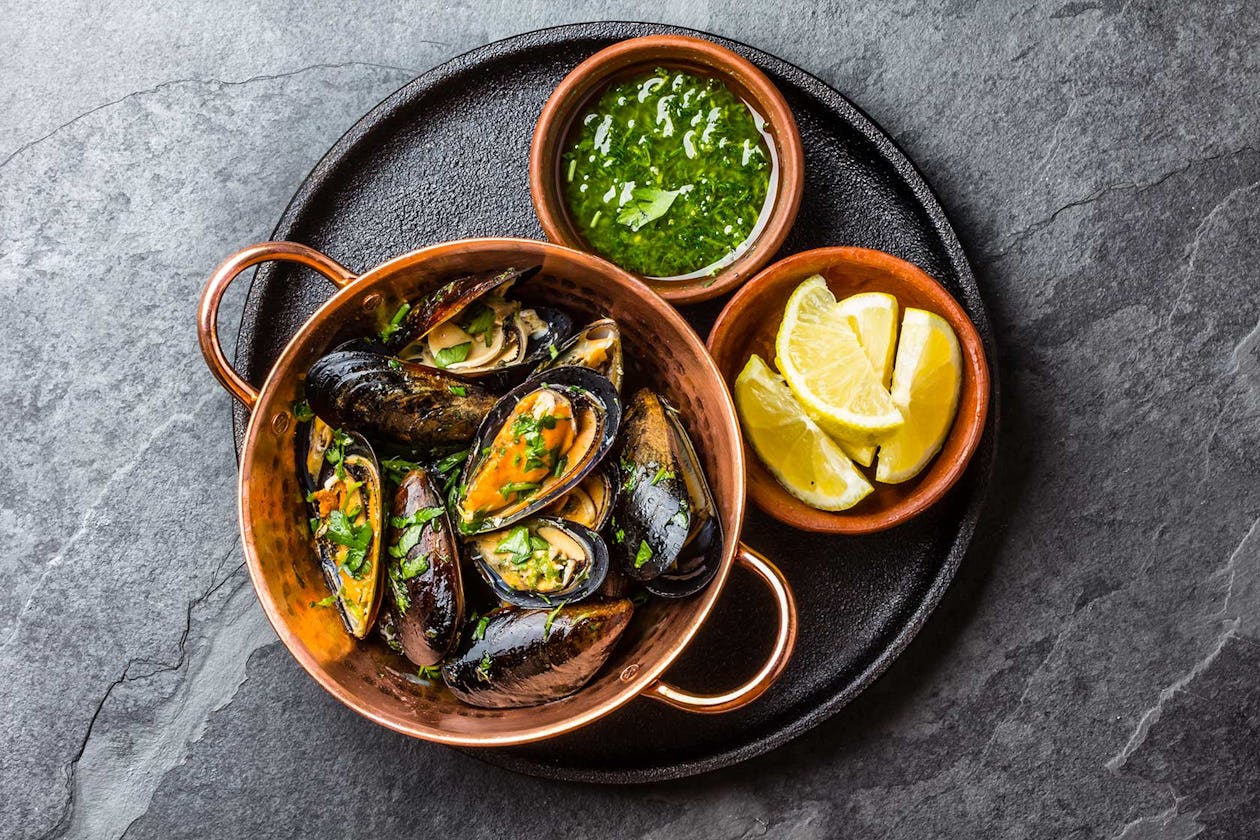 “What is and isn’t Paleo isn’t that interesting to me,” says Kresser. “I’m interested in what is and isn’t healthy. Paleo is just a great starting point for people to find their own approach to eating.”
“What is and isn’t Paleo isn’t that interesting to me,” says Kresser. “I’m interested in what is and isn’t healthy. Paleo is just a great starting point for people to find their own approach to eating.”
Our take? Let whole foods form the bulk of your diet, drawing mostly from the list of Paleo foods, and experiment with the dicey ones such as dairy and legumes. If you follow a high-protein diet, make sure to include organ meats and shellfish to ensure you get enough glycine to balance your methionine intake. Eat organic when you can, but don’t break the bank for it. If you work out or play sports, be aware that you may need more carbs than the average person, and be prepared to bend the rules on strict caveman nutrition to allow for them.
You can find more information on Chris Kresser at https://chriskresser.com.
You can find more information on Chris Mohr at https://mohrresults.com.
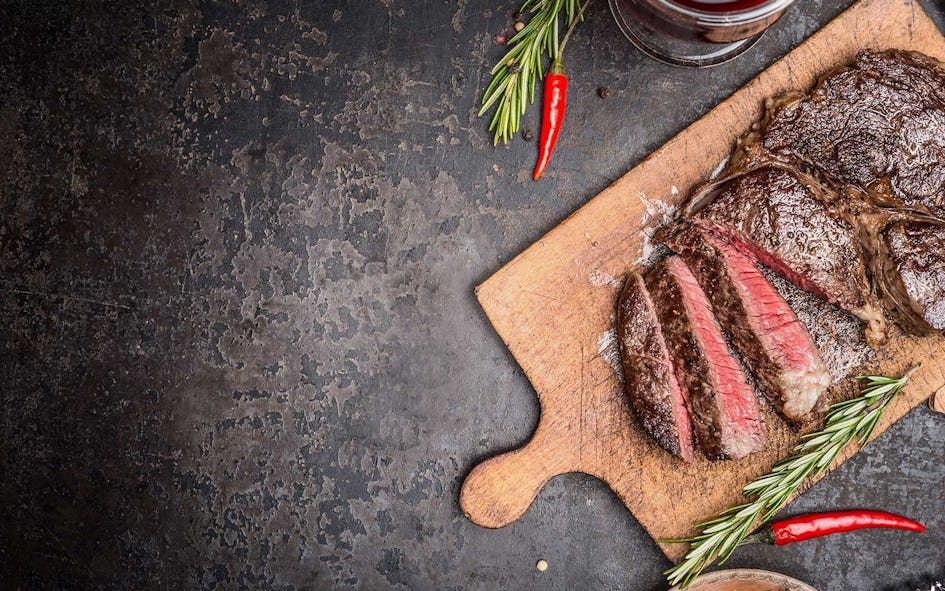
)

